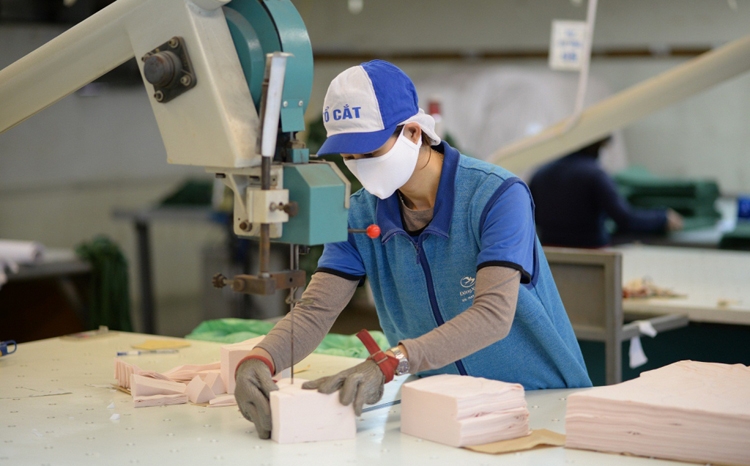 News
News
Enterprises face double pressure
According to statistics, in September, the textile and garment industry's exports decreased significantly, up to 11.7% compared to August, reaching 4 billion USD. In some major export markets, the industry's exports fell right in August, such as the US down 3%, the EU down 3.2% and continued the decline.
Mr. Truong Van Cam - Vice Chairman of Vietnam Textile and Apparel Association said: The situation in the fourth quarter of 2022 of the textile industry is very difficult, many businesses are lacking orders. Currently, only businesses with traditional customers have had production orders until the end of the year, even for the beginning of 2023, most of the rest are struggling to find demand sources, this situation can last until the end of the first quarter of 2023. . At the same time, the unit price decreased, many customers ordered the price to only reach 50%, even 40% compared to the normal level.
This information has also been released by SSi Research: The number of orders of domestic garment manufacturers in the fourth quarter of 2022 was 25 - 50% lower than in the second quarter of 2022. This situation is more serious for businesses with customers mainly in the US and EU. Exports to Japan and South Korea also tend to decrease, but to a much lesser extent.
Some enterprises in the textile and garment industry have begun to receive orders for the first quarter of 2023, but the number of orders received is still far from operating capacity. Most of the customers are negotiating to reduce the order. Even outsourcing orders, orders that customers only pay for labor costs are currently being pressured.
The above difficulties are determined by the main export markets of the industry such as the US and EU, with very high inflation, the highest in recent decades, up to 6-7%, sometimes up to 9-10% affected the consumption power of the people. The Russia-Ukraine conflict has a particularly serious impact, according to statistics, Vietnam's textile and garment exports to Russia account for 90-95% of the total turnover in this region and are currently negative 40-42% compared to the previous year. .
 |
|
Facing double pressure, textile and garment exports are still likely to reach their destination on time |
Another reason, after a long time of the epidemic, customers ordered a huge amount of goods, especially from the fourth quarter of 2021 to the middle of the year, even the end of July 2022. The large volume of goods encountered difficult economic times, high inflation, and markedly reduced consumption caused inventories to increase.
Mr. Truong Van Cam also said: Along with the decline in orders, exchange rate fluctuations are also having many impacts on textile enterprises. The dollar rose sharply against the domestic currency of Vietnam, exporting enterprises earned USD and converted to local currency, in the opposite direction, enterprises importing raw materials were at a disadvantage. Worth mentioning, Vietnam's textile and garment industry is currently importing a large proportion of raw materials, especially fabrics.
Mr. Pham Xuan Hong - Chairman of Ho Chi Minh City Textile, Embroidery and Knitting Association once shared: As an exporter but still importing raw materials for production, the rising exchange rate also puts a lot of pressure on textile enterprises. lucky. And businesses can't be happy because the price of imported raw materials keeps increasing sharply, making the difference in profit from the exchange rate almost negligible.
There is still a bright door to reach the right goal
In the face of double pressure and the market situation is forecasted to be difficult until the first quarter of 2023, but Mr. Truong Van Cam still said that: in 9 months, the textile and garment industry's exports are estimated to increase by 21%, reaching over 35 billion USD, on average. military reach 3.8-3.9 billion USD/month. If the market remains as bad as it is now, the textile and garment industry can also export about 3 billion USD/month. Thus, by the end of the year, the industry can still reach the target of 43.5-44 billion USD, even if the situation improves, it can reach a little higher.
Regarding the difficult factors that are putting pressure on businesses, leaders of the Vietnam Textile and Apparel Association noted: Enterprises closely monitor the situation, choose appropriate orders, maintain production, and ensure jobs for people. labor in the immediate future. Don't worry too much about signing long-term orders at low prices.
In the current situation, there are many solutions that businesses can apply, such as: Giving employees leave, reducing overtime hours, training workers. Enterprises take advantage of the time to implement programs at the request of export markets such as greening and digitization - this is an inevitable trend, when there is time, it should be implemented soon. Link together to share orders and retain customers. Dialogue with partners to share difficulties, build long-term, trusting relationships.
On the State side, Mr. Truong Van Cam, proposed: The Government soon approves the Strategy to develop the textile industry to 2030, with a vision to 2035 to determine the development space, where a textile industrial park can be built. Large garment factories have wastewater treatment facilities and ensure the supply of raw materials to meet the requirements for garment exports.
Solving problems with mechanisms and policies, the association has proposed tax on domestic fabrics for the production of export products. Speeding up the implementation of a support package of VND 35,000 billion to help businesses have more good conditions for production development, increase exports, and increase incomes for employees.
| Mr. Truong Van Cam - Vice Chairman of Vietnam Textile and Apparel Association: The current difficult situation will only last until the end of the first quarter of 2023, the target for 2023 of Vietnam's textile and garment industry is about 47-48 billion USD. exports; difficult case lasts until the middle of the year, the target is about 46 billion USD. |